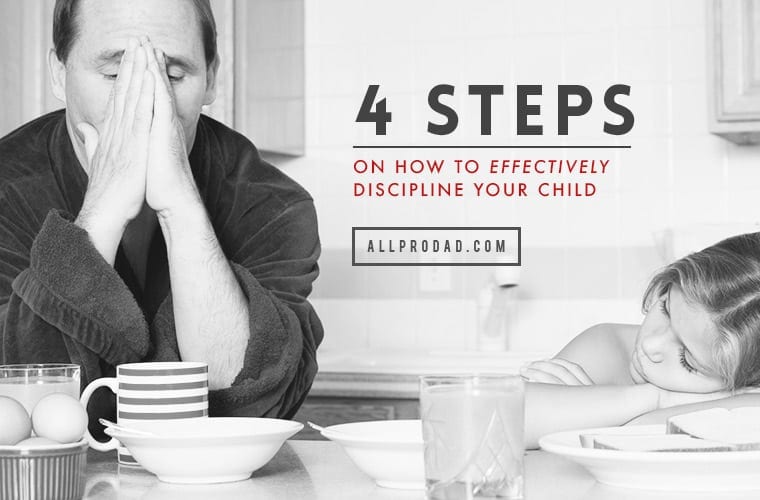When I first started dating my wife, I was leading a youth program. Every week, we had a large group meeting where we would lead the kids in fun activities. I thought she would be impressed with the way I delegated the leading of activities to the teenagers. At the end of the night, I asked her: “Well, what did you think?”
Without hesitation, she replied: “Honestly, that was horrible. You put the kids in charge of the activities, but you didn’t train them. You have to go through it with them beforehand and practice.” So I made training them a priority. I planned out a training course any time I put them in front of the group from then on and it made all the difference.
When you discipline your child, you are training them for the world.When you discipline your child, you are training them for the world. It helps to have some idea or plan in advance for how you will discipline your kids. Here are 22 ideas for how to discipline your child.
1. Be firm.
Set reasonable limits, explain them, and enforce them.
2. Be consistent.
Your children will learn to adapt to inconsistencies between you and their mother. If you allow jumping on the bed but she doesn’t, for example, they will do it when they’re with you and won’t when they’re with her. However, if you allow jumping one day and prohibit it the next, you’ll only confuse your children and undermine your attempts to get them to listen when you ask them to do something.
3. Compromise.
Kids can’t always tell the difference between big and little issues. So give in on a few small things once in a while (an extra piece of birthday cake at the end of a long day might prevent a tantrum). That will give your kids a feeling of control and will make it easier for them to go along with the program on the bigger issues (holding hands while crossing the street, for example).
4. Be assertive and specific.
“Stop throwing your food now” is much better than “cut that out!”
5. Give choices.
Kathryn Kvols, author of Redirecting Children’s Behavior, suggests, for example, that if your child is yanking all the books off a shelf in the living room, you ought to give him or her a choice: “Would you like to stop knocking the books off the shelf or would you like to go to your room?” If your children ignore your question, gently but firmly lead them to their rooms and tell them they can come back into the living room when they’re ready to listen to you.
6. Cut down on the warnings and don’t ever count.
If the child knows the rules, impose the promised consequences immediately. If you make a habit of giving six preliminary warnings and three “last” warnings before doing anything, your child will learn to start responding only after you’ve asked eight or nine times. The same is true if you count for children to obey. “Come here. I’m going to count to three. One, two…” Then they come. You are teaching them that they can wait until three to obey you. Instead, it’s, “Come here.” If they don’t come right away, they get a consequence.
7. Link consequences directly to the problem behavior.
Don’t forget clearly and simply to explain what you’re doing and why: “I’m taking away your hammer because you hit me,” or “I asked you not to take that egg out of the fridge and you didn’t listen to me. Now you’ll have to help me clean it up.”
8. No banking.
If you’re imposing punishments or consequences, do it immediately. You can’t punish children at the end of the day for something (or a bunch of things) they did earlier. They won’t associate the undesirable action with its consequences.
9. Keep it short.
Once the punishment is over, get back to your life. Once everything has been clearly explained and a consequence has been administered, drop it. There’s no need to continue to hit them with it over and over again.
10. Stay calm.
Screaming, ranting, or raving easily can cross the line into verbal abuse that can do long-term damage to your child’s self-esteem.
11. Get down to your child’s level.
When you’re talking to your children, especially to criticize, kneel or sit. You’ll still be big enough that they’ll know who the boss is.
12. Don’t lecture.
Instead, ask questions to engage the child in a discussion of the problematic behavior: “Is smoking cigars OK for kids or not?” “Do you like it when someone pushes you down in the park?”
13. Criticize the behavior, not the child.
Even such seemingly innocuous comments as “I’ve told you a thousand times” or “Every single time you—” gives children the message that they’re doomed to disappoint you no matter what they do.
14. Reinforce positive behavior.
We spend so much time criticizing negatives and not enough time complimenting the positives.We spend so much time criticizing negatives and not enough time complimenting the positives. Heartfelt comments like “I’m so proud of you when I see you cleaning up your toys” go a long way.
15. Play games.
“Let’s see who can put the most toys away” and “I bet I can put my shoes on before you can” are big favorites. But be sure not to put away more toys or to put your shoes on first—kids under five have a tough time losing.
16. Avoid tantrums.
Learn to recognize what triggers your child’s tantrums. The most common include exhaustion, overstimulation, hunger, and illness. Keeping those factors to a minimum will go a long way toward reducing tantrums.
17. Never spank in anger.
We know parents have strong feelings both for and against this type of discipline, but for some children it is effective when nothing else is. The key to successful spanking is knowing how and when to apply it. Never spank your child when you’re angry or upset. Wait until you’ve calmed down from the situation at hand so that, when you spank, you are acting rather than reacting. Explain to your child that this will be the consequence of certain behaviors, and remind him or her of the reason for the discipline before you administer the spanking. Spank your child only on the behind, and let this only be one of the methods of correction in your bag—not the sum total of your discipline strategy.
18. No shaking.
It may seem like a less violent way of expressing your frustrations than spanking, but it really isn’t. Shaking your baby can make his or her little brain rattle around inside the skull, possibly resulting in brain damage.
19. No bribes.
It’s tempting to pay children off to get them to do or not do something. But the risk—and it’s a big one—is that they will demand some kind of payment before complying with just about anything.
20. Be a grown-up.
Biting your children or pulling their hair to demonstrate that biting or hitting is wrong or doesn’t feel good will backfire. Guaranteed.
21. No whining.
Tell your children that you simply don’t respond to whining and that you won’t give them what they want until they ask the right way.
22. Set a good example.
If your children see you and their mother arguing without violence, they’ll learn to do the same. If they see you flouting authority by running red lights, they’ll do the same.
Many but not all of these ideas came from “22 Discipline Ideas That Really Work.”
Do you need more creative consequences for bad behavior? Here are 21.
Sound off: How do you discipline your kids?











Huddle up with your kids and ask, “Why do you think consequences are important when you do something wrong? What do you think would happen if you didn’t have any consequences?”